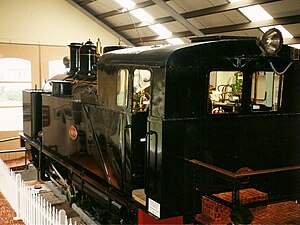NZR H class

H 199 in the Fell Engine Museum, 20 March 2002.
|
|||||||||||||||||||||||||||||||||||||
|
|||||||||||||||||||||||||||||||||||||
|
|||||||||||||||||||||||||||||||||||||
|
|||||||||||||||||||||||||||||||||||||
|
|||||||||||||||||||||||||||||||||||||
| Type and origin | |
|---|---|
| Power type | Steam |
| Builder |
Avonside Engine Co., England (4) Neilson & Co., Scotland (2) |
| Serial number | Avonside 1072–1075 Neilson 3468–3469 |
| Build date | 1875 (4) 1886 (2) |
| Specifications | |
|---|---|
| Configuration | 0-4-2T |
| Gauge | 3 ft 6 in (1,067 mm) |
| Wheel diameter | 32 in (813 mm) driving 23.5 in (597 mm) adhesion |
| Wheelbase | 14 ft 3 in (4.34 m) |
| Length | 24 ft 1 in (7.34 m) |
| Width | 8 ft 6 in (2.59 m) |
| Adhesive weight | 32.4 long tons (32.9 t; 36.3 short tons) |
| Loco weight | 39.8 long tons (40.4 t; 44.6 short tons) |
| Fuel type | Coal |
| Fuel capacity | 0.5 long tons (0.51 t; 0.56 short tons) |
| Water cap | 714 imp gal (3,250 L; 857 US gal) |
| Firebox: • Firegrate area |
16.8 sq ft (1.6 m2) |
| Boiler pressure | 160 psi (1,100 kPa) |
| Heating surface | 794 sq ft (73.8 m2) |
| Cylinders | Four total two driving, two adhesion |
| Cylinder size | 14 in × 16 in (356 mm × 406 mm) driving 12 in × 14 in (305 mm × 356 mm) adhesion |
| Valve gear |
Stephenson (199 - 202) Joy (203 - 204) |
| Performance figures | |
|---|---|
| Maximum speed | 15 mph (24 km/h) |
| Tractive effort | 12,550 lbf (55.8 kN) driving 11,000 lbf (49 kN) adhesion |
| Career | |
|---|---|
| Number in class | 6 |
| Numbers | 199 – 204 |
| Locale | Rimutaka Incline, Wairarapa, North Island |
| First run | 1878 |
| Last run | 29 October 1955 |
| Retired | March 1956 |
| Preserved | One (H 199) |
| Restored | 1981 - 1989 |
| Scrapped | 1956 |
| Current owner | Fell Engine Museum |
| Disposition | 5 scrapped 1 preserved |
The NZR H class locomotive was a unique class of locomotive used by the New Zealand Railways Department on the famous Rimutaka Incline, the 3-mile (4.8 km) section of 1 in 15 (6.67 %) gradient between Cross Creek and Summit, over the Rimutaka Ranges. The locomotives worked on the Fell mountain railway system and had four horizontal driving wheels between the frames, gripping a centre rail and providing the extra adhesion needed for the climb. The outside engines drove the rear pair of coupled wheels of 32 in (813 mm) diameter, and the inside cylinders four spring-loaded grip wheels of 22 in (559 mm) diameter. On the descent, powerful hand-brakes bore against the centre rail, and brake vans with similar braking gear were interspersed at intervals in the train. The locomotives were never required to run at speeds higher than 15 mph (24 km/h), and their usual operating speed was between four and six miles per hour (6.4 and 9.7 km/h) ascending the incline, about ten miles per hour (16 km/h) descending.
After the Second World War, the locomotives were starting to show their age, and the New Zealand government was looking for a way to cut time between Wellington and the Wairarapa. On 7 May 1951, the contract to construct the 8.8-kilometre (5.5 mi) Rimutaka Tunnel was let, which spelled the end of the incline, and the need for the H class.
The last revenue service for the H class was on 29 October 1955, when locomotives 199, 201, 202, 203 and 204 hauled a Carterton Show day excursion train up the incline on the return journey to Wellington. When the Rimutaka Tunnel opened five days later, two of the engines were put to work dismantling the incline that they had travelled on for 77 years.
After closure and dismantling of the line, in February 1956 all of the H Class - except H 200 which had been out of service for some time with a collapsed internal steam pipe - were towed to Hutt Workshops. All were written off in March 1956 and all except H 199 were towed to the old Silverstream rail yard in 1957 where they were scrapped. H 199 was towed to Featherston on 9 August 1958 by DE 508 (itself preserved) and put on display in the park in Clifford Square the following month. Years later the locomotive became the centre piece in the Fell Locomotive Museum at Featherston.
...
Wikipedia
